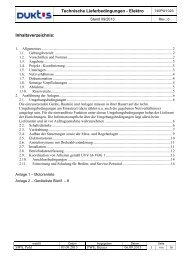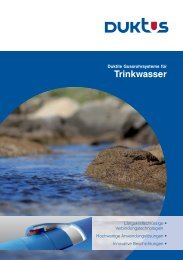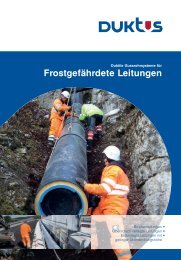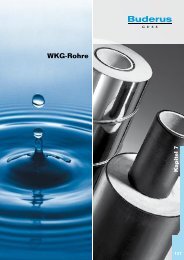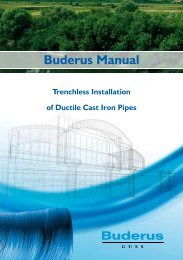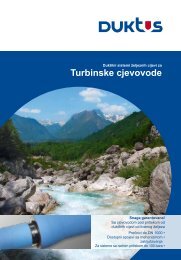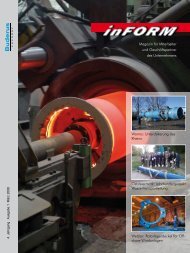inform 11.2011 e (pdf file 2 MB) - Duktus
inform 11.2011 e (pdf file 2 MB) - Duktus
inform 11.2011 e (pdf file 2 MB) - Duktus
You also want an ePaper? Increase the reach of your titles
YUMPU automatically turns print PDFs into web optimized ePapers that Google loves.
PAGE 12 | INFORM NO. 3 / 2011<br />
from the pumping station to the river Lippe<br />
A 1,200 mETRE SEWER PIPELINE fROm DUKTUS ENABLES fLOW INTO A RECEIvING WATERCOURSE<br />
TO BE REGULATED<br />
As a result of the effects of mining-related subsidence,<br />
the Gecksbach stream near Lippramsdorf<br />
– a village close to the town of Haltern am See in<br />
North Rhine-Westphalia – could no longer find its<br />
way unaided into the river Lippe. The lower<br />
course of the stream has therefore had to be<br />
moved. In future, the stream will flow to a new<br />
pumping station and from there will be pumped<br />
into the receiving watercourse via a 1,200 metre<br />
long pressure pipeline. The client is the Lippeverband,<br />
the body managing the central and lower<br />
Lippe. The operation is costing millions of Euros<br />
and the construction work for it began in autumn<br />
2010. <strong>Duktus</strong> DN 600 sewer pipes with BLS®<br />
joints were used for the installation of the pressure<br />
pipeline. In its planning work, the Lippeverband<br />
had to allow for the subsidence which can<br />
still be expected, because coal-mining is still going<br />
on in the region. In view of these ground conditions,<br />
the safety margins offered by the pipes<br />
had to meet very stringent requirements, as the<br />
pipeline will have to withstand the imponderables<br />
due to the unstable ground. As <strong>Duktus</strong> Sales<br />
Manager Jürgen Schütten explains, “This was<br />
also the reason why the Lippeverband opted for<br />
wall-thickness class K 9, to make sure that it<br />
would be on the safe side in the long term. The<br />
trench for the pipeline was constructed with watertight<br />
sheet-pile shoring. The operation was a<br />
challenging one and made special demands on<br />
<strong>Duktus</strong>’s Application Engineering Division. As<br />
The ductile iron pipes being connected into the manhole<br />
structure<br />
The DN 600 cast iron pipeline passing through the manhole<br />
structure<br />
well as the instruction of the site personnel, there<br />
were also complicated details which had to be<br />
settled. To meet the requirements imposed by the<br />
mining subsidence conditions, travels under traction<br />
and thrust had to be checked and suitably<br />
tailored so that the amounts of movement required<br />
could be made available by means of the<br />
existing tolerances at the sockets and some additional<br />
collars which would be needed. Once<br />
again, <strong>Duktus</strong> showed its expertise as an adviser<br />
and partner for the planners and the companies<br />
doing the installation work when demanding underground<br />
installation projects are being carried<br />
out.” The Haltern-Lippramsdorf pumping station<br />
went into operation early in April 2011. The job of<br />
laying the pressure pipeline, which was completed<br />
in June, was handled by Böwingloh & Helfbernd<br />
GmbH of Verl.<br />
Drinking water supply in the<br />
north of the Black forest<br />
mORE ThAN ThREE KILOmETRES Of DUKTUS zmU PIPES ARE ImPROvING<br />
ThE DRINKING WATER SITUATION AROUND BAD TEINACh-zAvELSTEIN<br />
To improve the drinking water supply to Bad Teinach-Zavelstein<br />
and other surrounding municipalities,<br />
local water utilities have decided to enter into<br />
a co-operative agreement with the large neighbouring<br />
utility Zweckverband Schwarzwald-Wasserversorgung<br />
and to expand the pipeline networks<br />
in three sections of installation work. More<br />
than three kilometres of<br />
150 nominal size <strong>Duktus</strong><br />
ZMU pipes with BLS®/<br />
VRS®-T joints are being<br />
laid for this. The ductile<br />
iron pipe is an accepted<br />
standard at the Zweckverband.<br />
For years, this drinking water supplier,<br />
which sends out around 2.2 million cubic metres<br />
of excellent water from the region every year, has<br />
been putting its trust in the durability and strength<br />
of the ductile material. The majority of the pipelines<br />
are being laid using the open trench tech-<br />
nique. “The cement mortar coating of the pipes<br />
saves money for clients because the soil dug out<br />
can all be backfilled and no additional bedding is<br />
needed for the pipes. As well as the immaculate<br />
corrosion protection that the ZMU coating provides,<br />
this was the reason why it was decided to<br />
lay all the sections in this grade of pipe”, <strong>Duktus</strong><br />
Sales Manager Alexander Bauer tells us. In September<br />
2011, some 200 metres of the future connecting<br />
pipeline to the Zavelstein high-level service<br />
reservoir was laid by the directional drilling technique.<br />
The consulting engineers, Alwin Eppler of<br />
Dornstetten, had opted for this variant laying technique<br />
because there was an old asbestos cement<br />
pipeline in the region concerned which needed to<br />
be replaced. “By laying by the directional drilling<br />
technique we were able to do the work at low cost<br />
and avoid any harmful effects on the environment”,<br />
says Willi Ruderisch, CEO of Flammer of<br />
Mössingen which did the installation work.<br />
A 200 metre long section of the future connecting pipeline to the Zavelstein high-level service reservoir was laid by the directional drilling<br />
technique. An old asbestos cement pipeline was replaced at this point



